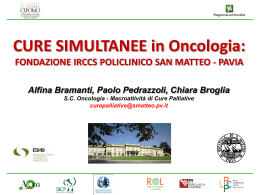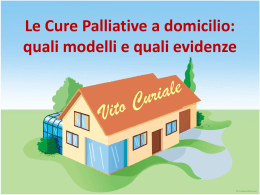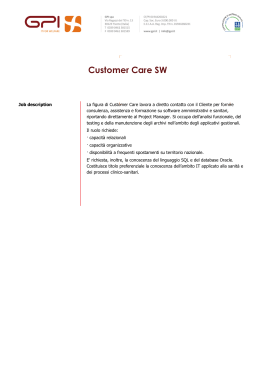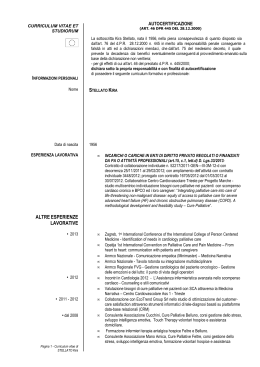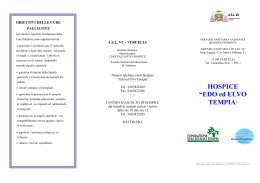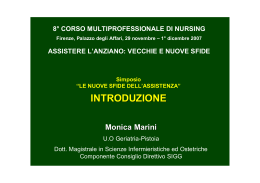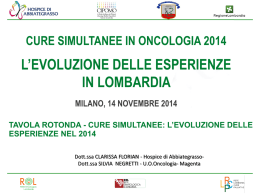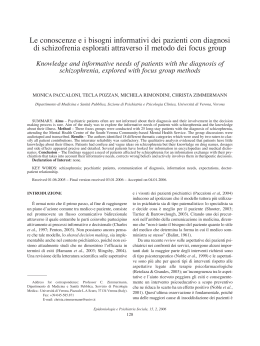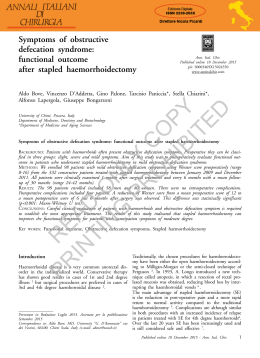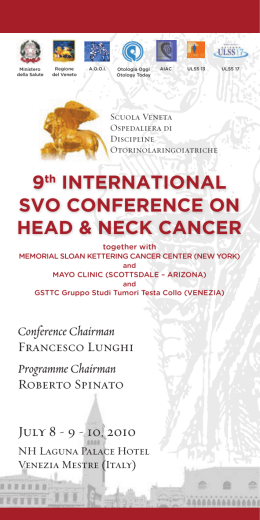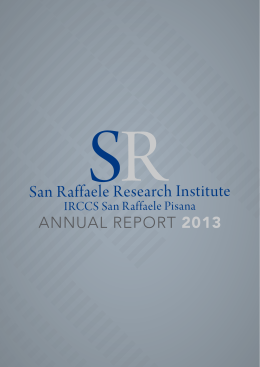La difficile gestione del paziente affetto da tumore del distretto testa-collo: sintomi, complicanze, tossicità da trattamento Il punto di vista di uno specialista di cure palliative Cristina Endrizzi Gabriella D’Amico Palliative care for patients with Head and Neck Cancer “I would like a quick return to a normal lifestyle” N. E. Goldstein et al., 2008, JAMA Palliative care provides support for the physical, emotional and psychological suffering of patients with any advanced illness, regardless of age, diagnosis or life expectancy. It differs from traditional end-of life care in that patients who receive palliative care can also continue to receive curative or life-prolonging treatments. Patients with head and neck cancers often have a relapsing course that is marked by periods of freedom from disease and symptoms, interspersed with bouts of serious illness. Debility and numerous physical and psychological symptoms including pain, dysphagia, weight loss, disfigurement, depression and xerostomia IL DOLORE È prevalentemente un dolore di tipo somatico correlato alle lesioni ulcerative. L’invasione dei nervi sia a livello periferico che per progressione alla base cranica può portare a sindromi dolorose refrattarie e a deficit neurologici. Esiste poi un dolore cronico postoperatorio o post trattamento radiante (per danno neurologico o retrazione tissutale, radiodermiti o mucositi severe). Il dolore è spesso il primo sintomo di una recidiva di malattia (Smith, Head & Neck 2001, lo riporta nel 70% dei pazienti con una mediana di 4 mesi tra insorgenza del dolore e diagnosi di recidiva). Pazienti con tumore testa-collo Ricoverati in Hospice dal 2012 ad aprile 2015 18 pazienti ricoverati- 2 dimessi a domicilio,16 deceduti in Hospice 4/18 (22%) pazienti già noti in ambulatorio terapia del dolore Età media 65 anni (7/18 > di 70 anni) Rapporto M:F = 2:1 Tempo medio di degenza 20 giorni (da 2 a 72 giorni) entro una settimana 6/18 da 10 a 20 giorni 8/18 > 30 giorni 4/18 PAP score: Gruppo C 6/18 Gruppo B 7/18 Gruppo A 5/18 Pazienti con tumore testa-collo Ricoverati in Hospice dal 2012 ad aprile 2015 Il ricovero in Hospice è avvenuto in media a distanza di 26 mesi dalla diagnosi: 8/18 (44%) pazienti entro un anno dalla diagnosi 4/18 (22%) pazienti dopo 4 anni dalla diagnosi Tumori stadio IV , 1 paziente con tumore stadio II 9/18 laringe; 6/18 orofaringe; 1/18 rinofaringe; 1/18 parotide; 1/18 orecchio Per lo più istotipo squamocellulare (G2 o G3); 1 epidermoide, 1 plasmocitoma 2/18 nessuna terapia 2/18 RT+CT 7/18 intervento chirurgico 4/18 intervento chirurgico associato a RT+CT 3/18 intervento chirurgico associato a sola RT Pazienti con tumore testa-collo Ricoverati in Hospice dal 2012 ad aprile 2015 Problemi di tipo clinico-assistenziale al momento del ricovero 8/18 PEG; 12/18 TRACHEOSTOMIA; MEDICAZIONI COMPLESSE 8/18 5/18 dolore associato ad ulcerazioni; 5/18 sepsi; 5/18 disfagia; 2/18 dispnea; 1/18 emorragia peristomale, emottisi terapia antalgica già in atto in 15/18 pazienti: paracetamolo 2/15; ossicodone 3/15; oppiaceo td 5/15; morfina cloridrato in pompa elastomerica 5/15 6/18 pazienti con depressione, ansia, angoscia, ritiro sociale 4/18 pazienti senza care giver Pazienti con tumore testa-collo Ricoverati in Hospice dal 2012 ad aprile 2015 Aggravamento in media dopo 13 giorni di ricovero (6/18 entro la prima settimana): dispnea 4/18; emorragia 4/18; scompenso cardiaco congestizio 3/18; 4/18 sepsi; 2/18 marasma; 1/18 dolore refrattario SEDAZIONE TERMINALE PALLIATIVA IN 14/18 PAZIENTI Body image, anxiety, depression, guilt and self-blame Facial disfigurement, problem with eating, weight of loss, speech impairment, costant sense of anxiety relating to concerns about relapse, often difficult social enviroment, alcohol consumption, sigarette smoking… Patients may blame themselves and feel they caused their own illness; they are to blame fot the impact the illness has on the quality of life of their loved ones …. Physicians can assist patients with these feelings by encouraging them to talk about them with their loved ones, and even facilitating these conversation…. Il “voglio guarire” e la constatazione “tutto cambia” evocano un pianto inconsolabile…non riesce a condividere le emozioni con il marito e ho il pensiero di un mondo interno compresso di stati d’animo che non hanno parole per esprimersi. Per la prima volta oggi si vede allo specchio, tutta intera e ancora piange. Lavoriamo sulla sensibilizzazione corporea, e si concentra in una piccola sequenza di gesti con le mani che si muovono attraversando l’aria. Oggi sarò il suo specchio, facendomi condurre in questa danza delle mani che ripeto insieme a lei. ….alla fine un grande sospiro la acquieta. Il lavoro si interrompe quando A. guarda il foglio come se fosse uno specchio d’acqua in cui vedersi riflessa: “Non ce la faccio, non ce la faccio proprio…non posso guardare” Care of the dying patient with Head and Neck cancer Signs include being bed-bound, semicomatose, only able to take sips of fluid, and and inabilityto take oral medications or tolerate artificial hydratation and nutrition. As such, families should be educated about how this once beneficial treatment may now be a sourse of suffering and stopping it should be considered. Another management issues is the “carotid blowout” syndrome. This process may take place gradually with occult blood loss into the surrounding tissues, or with rapid massive blood loss from neck. Patients with impending blowout should be managed in an inpatient setting, especially if children are present in the home; however there are caregivers who understand the nature of this complication and wish to have the patient remain at home. For patients with head and neck cancer the approach in multidisciplinary team is the key. C O N C L U S I O N I Although is evidence that multidiscplinary palliative care teams improve outcomes for patients [Higginson et al, J Pain Symptom Manage, 2003; Morrison et al N Engl J Med 2004] No studies to date have examined their advantages in patients with head and neck cancers. Integrating palliative care into the care plan at an earlier point in the course of the patient’s disease process may help to reinforce, for both patients and clinicians, the idea that palliative care is not the same as end-of-life
Scarica

